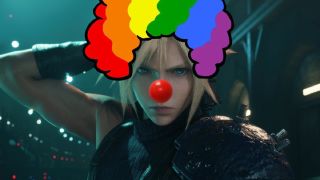After Resident Evil 4's remake, that notorious yellow paint discourse has come for Final Fantasy 7 Rebirth
Lazy or necessary?

Yellow Paint Discourse has once again hit the gamer networks. Shortly after the Final Fantasy 7 Rebirth demo went live, players and developers once again argued about the pros/cons of highlighting interactable objects with bright yellow paint.
This debate first erupted with Resident Evil 4 Remake's initial demo, returned when modders edited out the yellow paint and reared its ugly head once more when the full game launched. Arguments against yellow paint usually focused on how the obvious signposting would distract from everything else, while yellow paint defenders argued that players wouldn't be able to distinguish interactable parts of the world from the static set dressing - a feeling that was backed up by some developers and their playtesting anecdotes.
Both sides of the debate are back in full force, this time going in circles over a Final Fantasy 7 Rebirth screenshot (see below) that has Cloud climbing a rocky surface with shining yellow ledges guiding the player upwards. It's easy to dismiss these back-and-forths as uninteresting gamer complaints akin to arguing over puddles in Spider-Man, but I actually think the discourse highlights lots of interesting points on both sides.
THE YELLOW PAINT VIRUS HAS INFECTED FF7 pic.twitter.com/calN0dqHf4February 8, 2024
As Gamesradar's Austin Wood argued the first time this discussion came up, highlighting bits of the environment is good for legibility. Rather than punching every box and barrel and pot in the game, searching for a breakable one, highlighting a lootable is a quick way to save players time and avoid any frustration. That's fine! Signposting in this way only makes games more accessible for gamers with low visibility, too.
Game designer Dave Lockman shared that he once developed a game "where you can only jump and any button makes you jump." At one PAX show, the team put a giant button in front of the screen, and as Lockman recalled, players still asked "How do you jump?"
On the other hand, artist Freya Holmer reckons that games should have a clearer "distinction between the player path and the surroundings" and cut back on the visual noise that can sometimes make areas hard to read. "For some (including me), the yellow paint makes you feel like you are no longer discovering things yourself, you're just following signs, which removes the sense of discovery, experimentation, and, well, play," says Holmer. Maybe there can be a Shadow of the Tomb Raider-type compromise, where the paint is removed depending on your difficulty level?
Indie developer Rittzler - who was behind last year's incredible platformer Psuedoregalia - instead blames the yellow paint crutch on the fact that some blockbusters don't invest in secondary gameplay types "like exploration and puzzles." Many modern action-adventure blockbusters guide players across or up ledges, forcing them to push the analog stick in one direction without any real room for experimentation. "It's reduced to being simple time wasters that literally anyone (and I do mean anyone) can get through," the developer notes.
Sign up to the GamesRadar+ Newsletter
Weekly digests, tales from the communities you love, and more
What's the solution? Well, Rittzler points to Elden Ring as an example of a game that doesn't rely on such signposting, even if the traversal doesn't give you tons of options. Like Sekiro too, these games give you jumps and runs or grapples. Verbs that you can use at any point. So when you need to jump across a wide gap, the player utilizes an action they already have access to, rather than Cloud robotically deciding that he can now scale a rock formation.
Kaan freelances for various websites including Rock Paper Shotgun, Eurogamer, and this one, Gamesradar. He particularly enjoys writing about spooky indies, throwback RPGs, and anything that's vaguely silly. Also has an English Literature and Film Studies degree that he'll soon forget.
Most Popular



